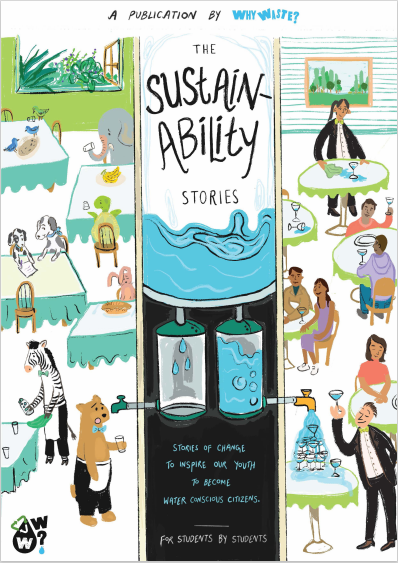#FreedomtoRead2020: Azad India Foundation on creating 70+ Surjapuri bilingual books
Posted by Remya Padmadas on February 21, 2020
Azad India Foundation (AIF) was founded by Yuman Hussain in 1998 to seed initiatives in education & primary health care. The organisation's activities reach out to marginalised women, adolescents and underserved children from rural and urban areas of the Kishanganj district in Bihar.
We are delighted that AIF is participating in our Freedom to Read campaign for the second year in a row. They are also our first partner-translator this year to have completed their goal of translating 70+ Surjapuri bilingual books (English-Surjapuri and Hindi-Surjapuri). In an email interview, Yuman Hussain, Executive Director of Azad India Foundation, tells us about the importance of bilingual books and how these books have helped children read and learn in their mother tongue.
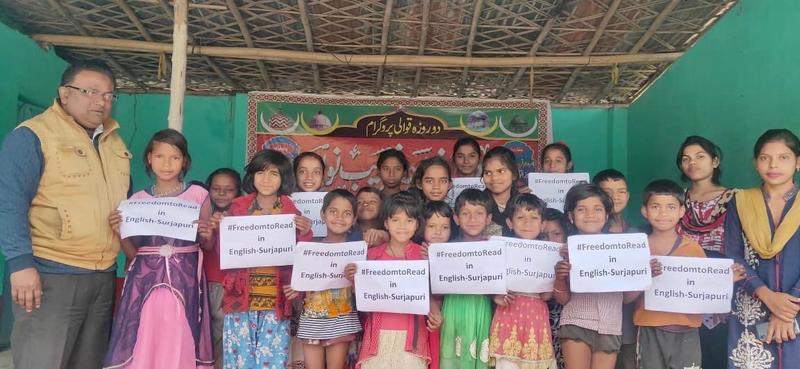
The Azad India Foundation team and the children in their learning centre in Bihar
“Azad India Foundation is delighted to be part of the #FreedomToRead campaign for the second year in a row. Foundational learning skills like reading are essential for a child’s progress. StoryWeaver is a unique platform that allows children to learn these skills joyfully in their mother tongue.”
- Yuman Hussain, Executive Director, Azad India Foundation
We are delighted that Azad India Foundation has participated in the Freedom to Read campaign for the second year in a row! How does it feel to be a part of the campaign for the second time?
It feels great to be part of the Freedom to Read campaign once again and to complete the translations well before time! The credit goes to the team. It was quite challenging this year as we chose to create bilingual books in English-Surjapuri.
Do tell us about the Surjapuri community and language: What is the mother tongue footprint and what resources are currently available? What are the challenges faced by Surjapuri children when they enter school?
Surjapuri is a dialect that is spoken in the Seemanchal area comprising Kishanganj, Araria, Katihar and Purnia of Bihar, and with minor variations in some parts of Bengal, neighboring Kishanganj.
I am currently not aware of any resources that are available for children in the local dialect of Surjapuri. In most schools, children learn in Hindi. In some schools, they are also taught in Urdu.
Can you tell us a little bit about how the Surjapuri books created from last year’s campaign are being used? Do the children have any favorites?
We have taken printouts of the Surjapuri books from last year’s Freedom to Read campaign and these are being used in classrooms for supplemental reading. Some of the STEM books are being used to explain maths and science concepts. The kids really like Gappu Can’t Dance (Gappu nachwa ne sakche) and enjoy enacting it in class. However, Fat King Thin Dog (Moto Raja Patla Kutta) is their all-time favourite!
This year, you’ve chosen to create bilingual books in English-Surjapuri and Hindi-Surjapuri. Could you tell us about the need and benefits of these books?
Bilingual books help children understand concepts easily, and if created in the local dialect, then it becomes so much easier for children to learn. The English-Surjapuri books are great teacher learning material (TLM) for non-Hindi or English speakers. Through StoryWeaver, we have access to thousands of free storybooks. We are aiming to create at least 200 books in Surjapuri on the platform.
We do not have reading material/storybooks in English for our children, so these bilingual books for level 1 and 2 are helping our children learn and read English. Aakansha, our India Fellow at AIF, helps with the reading sessions in English–Surjapuri.
Do tell us about your team who worked to create these 70+ Surjapuri bilingual books, and how they went about the translation process.
We have an enthusiastic young team of translators: Chand Quasar, Juhi and Saqlain, supervised by Muzzamil, who rose to the challenge once again. First, they translated storybooks from Hindi to Surjapuri. Then, I added the English version and uploaded the books on StoryWeaver. It was slightly challenging finding the corresponding words/sentences in English that matched the Surjapuri version, but it was fun.
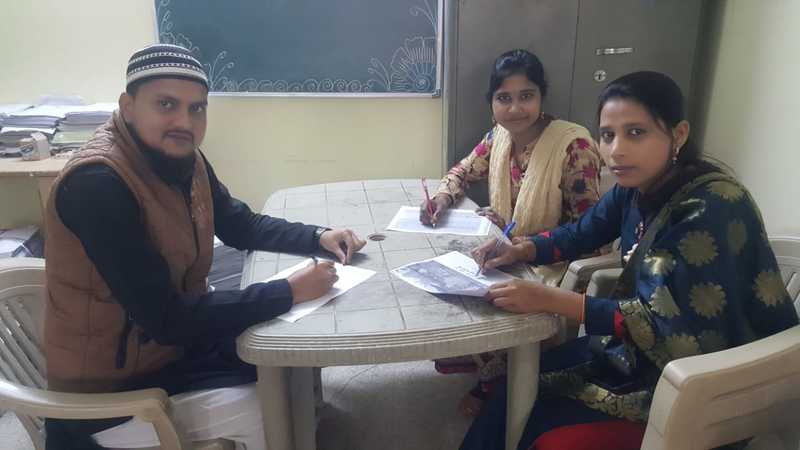
Azad India Foundation's Team Badhte Kadam
Thank you so much, Azad India Foundation, for giving children the #FreedomToRead in Surjapuri!
You can read all the storybooks translated by Azad India Foundation here.
Read more about the organisation here.
Do join the conversation by leaving your thoughts in the comments section below. You can also reach out to us through our social media channels: Facebook, Twitter and Instagram.
Be the first to comment.StoryWeaver’s exciting foray into the East.
Posted by Remya Padmadas on September 26, 2017The Outreach team recently made a big leap towards reaching children in West Bengal and Odisha through two workshops conducted in Kolkata and Bhubaneshwar.
First stop: Kolkata.
We prepped for the workshop, famous Kusum rolls in hand and Kolkata in turn rewarded us with a fantastic turnout. Around 60 participants joined us from 12+ organizations working with children across the education and social sector. People had traveled from Asansol, Purulia, Bardhaman,Chandipur and even Jamshedpur for the workshop! We were amazed by the level of engagement everyone brought to the table throughout the all-day session. One such organization which attended in large numbers was Vikramshila Education Resource Society which works on a range of projects from early childhood education to capacity building from Ladakh in the North to Andaman in the South. One of their team-members raised the point that in West Bengal, if you travel 20km in any direction, the dialect and vocabulary changes. This slipperiness of the language can make teaching and reading a real challenge.

“What happens when the vocabulary of the teacher is not understood by the students and vice versa though both are speaking slight variations of the same language? What happens when students don’t relate to the texts they are reading?”
These very pertinent questions were echoed by many of the organizations in attendance. Fortunately we also had with us an example of a possible solution in the form of two gentlemen from Suchana. Suchana is a 10 year old community group, which works in Birbhum district of West Bengal towards the education of pre-school to class 10 children from Santal and Kora adivasi communities. Their teacher-translators have used the ‘Translate’ functionality of StoryWeaver to great effect to develop supplementary reading materials in Kora and Santali. Currently, 27 Kora books and 19 Santali books, both in Bengali script are on StoryWeaver; all this made possible by the Creative Commons license we follow.
The ensuing discussion was another aspect of our workshops: to bring people doing such good work in different ways into the same space so that they can begin to talk to each other and find areas of synergy.
We jumped into speaking about how Pratham Books came into being and how StoryWeaver was designed to spread the power of stories to all children, particularly those with limited means to access quality books. We delved into our repository of free content from flashcards and spotting books for early readers to our STEM and Life-Skills based books. The books can be used in a variety of ways: getting children to relate things in their science class to real life, using illustrations as speaking or writing prompts, and so on.
We had with us storytellers, teachers, librarians, program managers and content heads. They all put their heads together to visualize how to adapt the LSRW (Listening - Speaking - Reading - Writing) framework and content on StoryWeaver to their programs. Kolkata being the city of adda, we got into a debate of course about what kind of content we can and cannot show our children.
After a demo of how to translate and create your own stories on the platform, the participants got to work. We ended with different groups showcasing stories they had created on the platform during their work-time and we bid adieu with a group picture.
On to Bhubaneshwar we went!
We were greeted by the green, clean city with wide roads and took advantage of the day to plan for the workshop and also to fill our stomachs with ‘dalma’! The next morning at the workshop people began pouring in from diverse organizations like Patang and Nilachal Seva Pratisthan who work in rural areas on programs including literacy for children and employable skill-development training for young adults. A number of organizations working with tribal children and reading and literacy programs were also in attendance such as SELCO, American India Foundation and Bakul Foundation. All of us were gathered in the room with one mission - how do we get children of Odisha access to more books to read in languages they love and understand.
The main challenge that came up during discussion was once again finding adequate content and stories that represented experiences children could actually relate to, in languages that they felt comfortable with. This was where we introduced the audience to our Adi Kahani series- a set of 10 books based on the culture of tribal communities in Odisha, with stories developed and illustrated by local writers and illustrators and published in local tribal languages.
Participants curated and presented lists of stories based on themes they wanted to teach like using ‘Cube Cat Cone Cat’ to teach shapes and dimensions in Math. Some interesting directions were explored during the course of the workshop: Gram Tarang which is involved in skill training and also runs Tarang Vaani, an IVR radio was interested in recording some of our stories and airing them on radio to reach a wider audience! A team member from Sikshasandhan immediately expressed interest in collaborating to make this happen.
The most lively time came during an ice breaker post lunch: we had to learn how to make paper planes out of the resource challenges we’d previously penned down, fly them across the room and pick up a different plane to see if there was any overlap in challenges faced. After all the plane throwing and giggling was over, we settled down into work-time where participants aired the sentiment of common resource challenge and shared the stories they’d translated into Odia and some new creations as well.
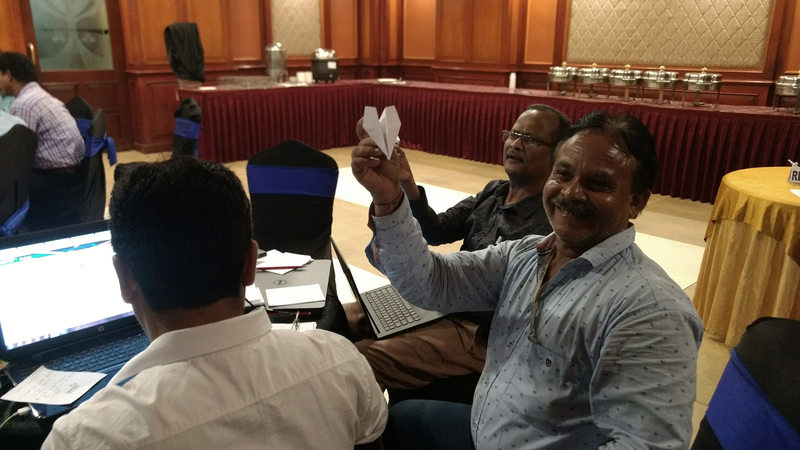
With a last hurrah and a group picture, we said goodbye to Bhubaneshwar. It had been a long, productive week and we were ready to go home and catch some well-deserved rest.
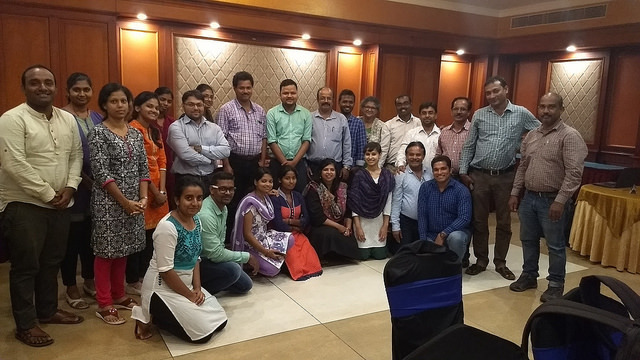
A conversation with Garvita Gulhati, Founder & CEO of 'Why Waste?', discussing their Sustainability Stories book series on StoryWeaver
Posted by Pallavi Kamath on December 03, 2020New books on StoryWeaver!
Presenting ‘The Sustainability Stories’ - a collection of stories conceptualised and published by not-for-profit organisation Why Waste?, written by young adults, for young adults in the making. Explore concepts of water conservation through the lives of Zelly the Zebra, Hali the Elephant, Lonely Cloud, and many more. Learn about the water cycle, Why Waste’s famous #GlassHalfFull concept, the mindful usage of water, and most of all, inspire young minds to be the change that they wish to see in the world!
Learn about Why Waste's work and the inspiration that led to the creation of the Sustainability Stories, in this conversation with their Founder & CEO, Garvita Gulhati:
Tell us about Why Waste?, and your work in the area of water conservation.
Garvita: Why Waste? is a not-for-profit organisation, with a team of like-minded youth who are taking water positivity to the world stage, by means of innovative education and ideas that bring about a systemic change. Why Waste? was founded in 2015 with the aim of changing the mindsets of people towards natural resources, specifically water and envisioning building a world of water conscious citizens. Why Waste?’s #GlassHalfFull movement to conserve water in restaurants went viral in 2019 and continues to have a massive positive impact on the industry with the support of NRAI. Why Waste? has been recognised as an ‘Ashoka Youth Venture’ in 2016. In 2020, the team became India’s largest youth-led movement by an organisation working towards water conservation and have been named as “Water Heros” by Republic TV in a collaborative initiative with the Government of India (Ministry of Jal Shakti).
Some of our initiatives include:
The Urban Water Challenge which is an annual child development programme that helps rural children to come up with innovative ideas towards sustainability.
Prerana- Story-telling sessions at NGOs and rural schools where the team talk about the sustainable stories created by Why Waste?.
Annual World Water Day Event where the team of Why Waste? celebrate water and demonstrate the importance of water conservation with fun-filled activities.
Hopeschooling, a recent initiative by Why Waste? in order to spread hope, motivation and raise awareness about pressing issues in the current world. This initiative was started during the peak of Covid-19, to encourage people to be better.
What inspired you to conceptualise the Sustainability Stories book series?
Garvita: I remember celebrating more birthdays at orphanages than at parties - Always having to finish all the food that I took on my plate. Through my early life, I learnt to empathize and enforce positive habits. The social sensitivity in me comes from practices like this, inculcated through my formative years. Understanding how crucial those experiences were, I conceptualised this series.Through the stories in this series, we hope that children inculcate these same values from a very young age, in a way best known to them - through fables and fairytales.
We are at a point where the world is now restructuring and reconsidering what the youth learn. The team at Why Waste? decided to take a step towards this by introducing stories that inspire our generation to not just love our planet, but also work towards a more holistic and sustainable world. Thereby, shaping our futures.
We would love to know more about the making of these books, especially the "For students, by students" aspect.
Garvita: Being a 100% youth-led movement, Why Waste? has always had wonderful young people volunteer and our goal is to always ensure that they are using their best talents to support our efforts and channel their changemaking energy. When the book was conceptualised, it was almost an obvious choice to have young writers, editors and illustrators create the entire book. It was fascinating to see the energy and new-world concepts that came in with this and truly a perfect amalgamation of varied perspectives.
I would like to thank the entire creative team of writers & designers for putting together a wonderful collection of inspiring stories.
What is the message that you hope to share through these stories?
Garvita: Each story talks about taking the lead and making a difference. We hope that this series will create a conservationist mindset in our future generations. Tomorrow may be far, but what we make of our children today is what we will see tomorrow.
How did you get to know about StoryWeaver, and what prompted you to open-license the Sustainability Series and make it available on our platform?
Garvita: I’ve been reading Pratham Books since I was a little girl. I still remember this particular book with Warli illustrations all over intrigued me so much I went on to not only enjoy the story but also learn Warli painting after that and create a lot of art. That’s the power of Pratham Books!
With the world spending more time online due to COVID-19, I learned that Pratham Books was online too, giving access to their wonderful books via StoryWeaver. I was incredibly intrigued by the power of this platform. Hence, open-licensing and putting our books out on StoryWeaver became an absolute no-brainer! The Sustainability Series is available to purchase on Amazon, but we are going to change the format to make it available for free and then let people donate as much as they want. This would also go in tandem with our work with StoryWeaver!
We are truly inspired by the work happening here and the phenomenal independence given to creators. Moreover, the simple goal of getting stories to as many young people as possible is truly what mattered the most, and made us really want to share our books here too!
Thank you, Garvita and Team 'Why Waste?'. We are delighted to have you on board as publishers on StoryWeaver!
Click on the link to read the Sustainability Series on StoryWeaver: https://bit.ly/37apTFP
Learn more about Why Waste? here.
